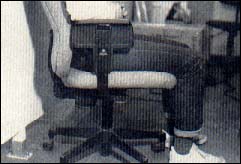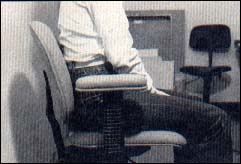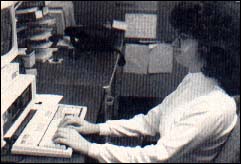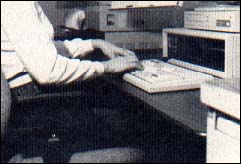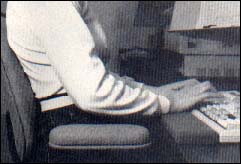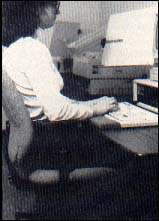The Body Electronic
Part I: Ergonomics
REBECCA ROSEN LUM
Labor saving devices are supposed to help, not hurt. But the computer, the wunderkind of productivity tools, has been associated with health hazards ranging from inflamed wrists to miscarriages. In the first of two articles, Rebecca Rosen Lum explains how a properly designed workstation can prevent crippling injuries.
|
|
The last thing syndicated newspaper columnist Denise Caruso expected while working at home on her personal computer was an on-the-job injury. When the 33-year-old San Franciscan began experiencing numbness in her arm, she chalked it up to an old shoulder injury and kept on typing.
But the numbness, as it turned out, was the harbinger of tendinitis, which required medical treatment, wrist braces worn day and night, and--most worrisome for a writer--no typing for a month. Despondent, Caruso wondered if she would have to find a new career.
Caruso says she believes her tendinitis is the result of years of typing at a too-high table while "twisted up like a pretzel." By the time she sought medical help, she says, "I couldn't move my fingers more than a half an inch."
Injuries Increase
Ailments like Caruso's are on the rise. Occupational health specialists call them repetitive strain injuries, or RSI. Such injuries are caused by continuous, repeated movements of the hands, arms or shoulders--like those made while keying at the computer. Over-stressed, tissues and tendons swell, rubbing against bone and ligament, and sometimes compressing nearby nerves. The result: tingling, numbness, burning sensations, and, all too often, chronic, teeth-grinding pain.
Until recently, RSI was thought to strike mostly blue-collar workers who labored in assembly lines and packing plants. But sufferers can include musicians, surgeons and others whose work involves articulated, repetitive hand movements. To their dismay, computer users are learning that they, too, are at prime risk for this debilitating injury.
Like Caruso, Caroline Rose, writer, editor and manager of a small computer firm, ignored the burning sensation in her forearm until it became unbearable.
"I continued to work for about two months before I realized I couldn't go on," says the 42-year-old Redwood City, Calif., resident. Ten months later, her suffering continues unabated. The diagnosis: tendinitis.
"I tried it all," she says. "Oral anti-inflammatories, steroid injections, acupuncture. Every doctor I saw said, 'It will go away in six or seven months.'"
Instead, the pain worsened, spreading to her elbows. And she doesn't know when, or if, her tendinitis will end. "After trying everything, my doctor is now saying to just 'work through' the pain," she explains.
|
|
Rose is not alone, as she discovered when she put out the word recently that she would like to start a support group for RSI sufferers and was deluged with calls before her first meeting.
In some workplaces, the injuries are epidemic. At the Los Angeles Times, for example, one fourth of reporters and editors have sought medical treatment for RSI. The union at U.S. West telephone company in Denver, Colo., reports 187 cases of RSI, many of which have required surgery.
"Computeritis"
Caruso and Rose's bouts with RSI, known in computer circles as "the VDT disease" and "computeritis," are the unexpected side effect of the computer revolution. Business Week magazine pronounced it the fastest-growing of all work-related ailments. Occupational health experts dubbed it "the worker's disease of the 90's." Since 1978, the number of RSI cases surged from 14 percent of all work-related illnesses to 50 percent in 1989.
Often misdiagnosed as arthritis, the number of RSI cases may be much higher than the 200,000 reported by government officials in 1989. Research scientist Dr. Barbara Silverstein of the University of Michigan recently told a congressional subcommittee that RSI may hit workers at 100 times the rate reported by OSHA. In California's high-tech capital, Santa Clara County, she said doctors reported treating nearly 4,000 cases of work-related RSI in 1987--the same year the State Department of Industrial Relations claimed the number to be 71.
Along with the rate of injury, the cost of treatment is soaring. The worker who develops carpal tunnel syndrome, a particularly crippling form of RSI in which swollen tendons hit the median nerve of the wrist within its tunnel-like casing, may run up a tab of $10,000 to $100,000 in one year alone in combined lost wages and medical care, one study revealed. Nationally, Dr. Roger Stephens of the U.S. Labor Department estimates employers spend $4 billion a year on the treatment of RSI.
One reason for the high medical cost of RSI may be delayed treatment. Doctors stress that RSI does not result from a single injury, but from a series of micro-traumas. When tendinitis sufferers continue using their hands or arms they keep injuring the tendon in tiny little ways. Delaying treatment of carpal tunnel syndrome is worse; chronic sufferers may find relief only through surgery.
No one knows this better than Bill Growney, an Arizona resident and carpal tunnel sufferer. "My arm felt like a hunk of meat that didn't belong to me," he says. By the time he sought treatment, he recalls, "I couldn't hold the telephone for more than 30 seconds without switching hands. I couldn't reach over the edge of the pot to stir the soup without waves of pain spreading up my arm."
A Utah surgeon performed a simple, brief procedure on both hands, but weeks later, Growney is still recovering his grip. "I can barely take the lid off the peanut butter jar," he says. "Every faucet in the house is leaking because I can't twist them hard enough to shut them all the way off."
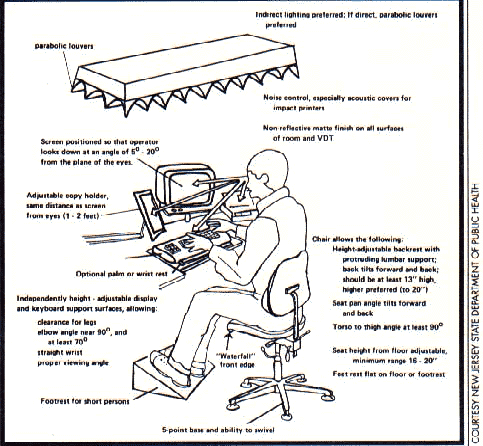 |
Prevention Is The Best Medicine
Like many other victims of this tenacious condition, Growney stressed that prevention beats medical intervention. Ergonomists, who study the best placement of objects for safe and effective use by humans, say the best defense is a workstation tailored specifically to the user's physical dimensions.
Laura Stock, associate director of the Labor Occupational Health Program at the University of California at Berkeley, warns that personal computer users have only an illusion of safety while working at home.
|
|
"At home, you have control, you can move about more freely," says Stock, who also directs the VDT Coalition, a group of 25 unions promoting computer safety issues. "But I see very little difference [between home and the workplace] if you work long hours in an awkward position. The issues are the same." Other experts agree.
"The keyboard, the document, the chair and the floor rest have to be fully adjustable," says physical therapist Terry Hansford of Hand Therapy, a clinic in San Francisco. "The kitchen table is not adjustable."
Yet that's exactly where many people plunk their computers to plunge into hours of work. A risky mistake, says Dr. David Rempel, an epidemiologist, research scientist and assistant professor at the University of California at San Francisco Medical School.
|
|
Rempel, an affable man who clearly enjoys his role in demystifying ergonomics, works out of a small, immaculately organized office at the Department of Public Health in Berkeley, Calif., filled with examples of good and bad computer setups.
"I tell people, 'Keep your table as low as possible,"' he says, demonstrating by sliding his own long legs under a simple, adjustable table.
"There should be one inch of clearance between the table and your legs." Raising the hands to touch a too-high keyboard, he says, is rough on the biceps, shoulders and back and stresses the nerve tunnels that run through the wrists. He cautions against raising the keyboard to an angle for the same reason. "And, if you weren't taught to 'float' your wrists above the keyboard like trained typists are, use wrist rests"--foam rubber supports that keep the wrists parallel to the ground.
A crucial piece in the ergonomic puzzle is the chair. The angle of the seat, the chair height and the back should all be adjustable, he says. And the backrest should be at a slight backward angle; otherwise, the weight settles flat on the base of the spine, defeating the purpose of a back rest.
Expensive? Well, yes. "I think people should put a lot into their chairs," says Rempel, who vows his own was well worth the $700 he paid for it. "We're sitting in the bloody things more than we're in bed."
 |
| Poor ergonomics at the keyboard usually affects the hands and arms. Tendinitis causes the tendons to swell and rub against bones, liga- ments and nerves. Carpal tunnel syndrome results from swollen ten- dons hitting the median nerve. |
Take Five
But if the chair is so comfortable the user never wants to leave it, another problem arises. Studies by the National Institute for Occupational Safety and Health (NIOSH) have revealed that long periods of time spent sitting at a keyboard lead to a condition called "static loading." Because the muscles are not being flexed, but continually contracted, circulation slows down. Fresh nutrients do not flow to the muscles as fast as they need to, and waste products, like Iactic acid, settle there much longer than they should. The upshot: soreness and pain.
"I believe in moving around," says Rempel. "Don't tie up one muscle group all day long."
Breaks, at least, are free. Many home computer users lament that they do not have an employer to pick up the tab for costly ergonomic equipment. Fortunately, home users do not have to choose between physically crippling ailments and a financially crippling, state-of-the-art workstation, says the VDT Coalition's Stock.
"You can retro-fit existing equipment," she says, suggesting inexpensive alternatives, "like foam rubber strips instead of specially made $20 wrist rests."
Rempel, who perches his own monitor atop a fat occupational medicine textbook, advises others to use books to buoy their monitors. And he would rather the home user rig a table from a piece of plywood and two sawhorses than buy an elegant hardwood desk with drawers under the top surface that make it impossible to get the keyboard low enough.
"Medical treatment, if you are not working at the right workstation for your body, will do you no good," he warns.
|
|
A light Touch
In a 1989 study he made of 137 VDT users, Rempel found 50 percent suffered from RSI symptoms--all directly attributable to poor ergonomics. Yet he stresses that RSI symptoms frequently result from the amount of pressure a typist brings to bear on the keyboard.
"You have to look at technique," says orthopedist and hand surgeon Dr. Robert Markison. Before designing treatment programs for his patients, Markison first watches them work the keyboard to see whether they are using undue pressure and sending shock waves through the already aching tendons of their forearms.
"Some people really hammer away," says Markison, who is having his San Francisco high-rise office suite enlarged to accommodate the crush of RSI sufferers. "In a seasoned typist, like a court reporter, there is an incredible economy of motion," he says. "Creative people sit down, and, after a while, they're pounding away like Rachmaninoff."
They're also vulnerable to overwork, a nemesis so threatening to a keyboardist's health that Markison proposes that all software should include a built-in timer to mandate breaks.
David Kaplan, now a patient of Markison's, blames his tendinitis on the three-month stint he put in at the keyboard writing a book. His doggedness culminated in a 12-hour session --"with breaks, mind you"--that brought him into Markison with swollen, aching hands.
"The problem is, you get enraptured," he says. "An hour can pass quickly, which is one of the magic things about writing. Unfortunately, in these days of computers, that can be dangerous."
Now, instead of writing, the 34-year old Kaplan spends hours each day doing gentle stretching exercises, squeezing sponges to rehabilitate his muscles and tendons, soaking his hands and resting them completely, with frequent hand massages from his wife, a physical therapist. He expects to recover, but "there will be no more 12-hour days, that's for sure."
"The hand is a dynamic piece of equipment, and nobody knows what the warranty is," says Markison. He advises computer users to gently stretch their fingers before beginning work and to take stock of their total health. "The heavier your forearm, the thicker the mantle of fat" compressing the tendons, he says. "Keep your weight down. Limit caffeine intake; that prevents spasms of the blood vessels. Smoking shuts down circulation."
The Body Electronic
Writer Kaplan says to follow the experts' advice.
"RSI is sneaky," he says. "It will creep up on you, even if you are aware of its effects. Prevention is a hell of a lot easier than getting RSI. It puts you out of commission for weeks. And your hands are everything."
Rebecca Rosen Lum is a San Francisco-based freelance writer.
|
|

